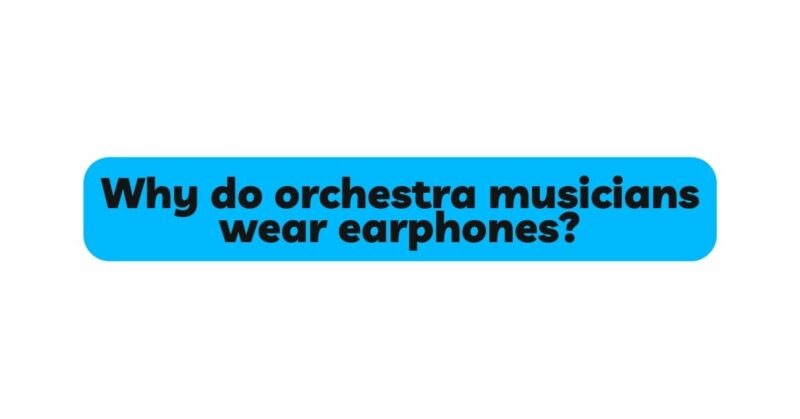In the realm of orchestral music, precision and cohesion are of paramount importance. When observing an orchestra performance, you may have noticed that many musicians wear earphones or in-ear monitors. These devices serve a critical purpose, providing individualized sound reinforcement and enhancing the overall orchestral experience. In this article, we will explore the reasons why orchestra musicians wear earphones, highlighting the benefits and practicalities of this practice.
- Personalized Monitoring: One of the primary reasons orchestra musicians wear earphones is to receive personalized monitoring. In large orchestras, musicians are spread across the stage, and it can be challenging to hear other sections clearly. Earphones provide an individualized audio feed, allowing musicians to hear themselves, their section, and other critical musical cues with precision. This personalized monitoring ensures that each musician can play in sync with the rest of the ensemble, contributing to the overall cohesiveness and balance of the orchestral performance.
- Ensuring Intonation and Pitch Accuracy: In an orchestra, maintaining accurate intonation and pitch is crucial for creating a harmonious blend. Earphones help musicians hear their own instrument or section with clarity, enabling them to adjust their intonation in real-time. This is especially important for instruments like strings, where small adjustments in finger placement can significantly impact the overall pitch accuracy. With earphones, musicians can monitor their intonation and make subtle corrections, resulting in a seamless and unified sound across the orchestra.
- Balancing Ensemble Dynamics: Achieving balanced dynamics is essential in orchestral music. Earphones allow musicians to hear the other sections and the overall ensemble balance more accurately. By having a clear audio representation of the entire orchestral sound, musicians can adjust their playing dynamics accordingly, ensuring that their instrument’s volume is appropriately balanced within the ensemble. Earphones provide a detailed sonic picture, allowing musicians to contribute to a well-balanced and dynamic orchestral performance.
- Timing and Rhythmic Precision: Orchestral music demands precise timing and rhythmic synchronization. Earphones play a vital role in helping musicians stay in perfect time with the conductor and the rest of the orchestra. The audio feed through the earphones can include a click track or metronome, providing a constant reference for maintaining the desired tempo. This ensures that all musicians are synchronized, enhancing the overall rhythmic precision and creating a cohesive musical performance.
- Hearing Subtle Musical Cues: In orchestral music, there are often intricate musical cues and transitions that require precise timing and coordination. Earphones enable musicians to hear these subtle cues more clearly, allowing for seamless transitions between different sections, solos, or ensemble passages. This heightened awareness of musical cues ensures that the orchestra performs with accuracy and musicality, creating a rich and expressive performance.
- Communication and Conductor Guidance: Earphones facilitate effective communication between orchestra musicians and the conductor. The conductor can provide instructions, interpretive guidance, or tempo adjustments through a microphone or talkback system connected to the musicians’ earphones. This real-time communication ensures that the entire orchestra is in sync with the conductor’s vision and interpretation, enhancing the overall artistic coherence of the performance.
- Hearing Protection: Orchestra musicians are exposed to loud sound levels, especially when sitting close to brass or percussion sections. Earphones provide a form of hearing protection by attenuating the overall sound levels while still delivering a clear and balanced audio feed. This protects musicians’ hearing health, allowing them to perform comfortably and confidently without compromising their auditory well-being.
- Individualized Sound Reinforcement: In large concert halls or acoustically challenging venues, earphones serve as a form of sound reinforcement for individual musicians. The earphones deliver a direct and isolated audio feed, ensuring that musicians can hear their own instrument or section clearly, even in reverberant or distant listening conditions. This individualized sound reinforcement contributes to musicians’ ability to accurately monitor their playing and maintain the desired musical balance within the ensemble.
- Enhanced Focus and Musical Engagement: Earphones help create a focused and immersive musical experience for orchestra musicians. By providing a controlled audio feed directly to the musicians’ ears, earphones minimize external distractions, allowing musicians to concentrate on their playing and the overall orchestral performance. This heightened focus and engagement contribute to a more expressive and emotionally compelling rendition of the music.
- Integration of Electronic Instruments or Sound Effects: In modern orchestral compositions, electronic instruments or sound effects may be incorporated. Earphones enable musicians to hear these electronic elements in real-time, ensuring that their performance aligns seamlessly with the electronic components of the composition. This integration of electronic instruments adds a new dimension to the orchestral sound and requires precise monitoring to achieve a cohesive blend between acoustic and electronic elements.
Conclusion: The use of earphones by orchestra musicians serves multiple purposes, all aimed at enhancing the precision, balance, and overall musicality of the ensemble. Earphones provide personalized monitoring, ensuring that musicians can hear themselves and the rest of the orchestra with clarity and accuracy. They help musicians maintain intonation, balance dynamics, and synchronize timing. Earphones enable effective communication with the conductor and protect musicians’ hearing. They also facilitate a focused and immersive musical experience, allowing musicians to fully engage with the performance. With earphones, orchestra musicians can collectively create breathtaking performances that captivate audiences and showcase the remarkable power of orchestral music.


